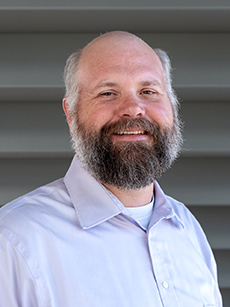Cary Rivard
Professor of Horticulture and Natural Resources
Extension Specialist
Director of the Olathe Horticulture Center
 Contact Info
Contact Info
crivard@k-state.edu
816-806-3734
Cary Rivard was born and raised near Kansas City, Missouri, where his family owns and operates a small, retail greenhouse business. It was here that he first became interested not only in propagation and greenhouse management, but also learning and teaching about plants.
He received his B.S. in agricultural sciences and biology from Truman State University in Kirksville, Missouri. He completed his M.S. and Ph.D. in plant pathology at North Carolina State University as a member of the Integrated Disease Management Lab.Rivard's graduate research was focused on tomato, but as a student he also worked with several crops, including strawberry, pepper, tomato, and cucurbits, and has experience working and conducting research in high tunnel production systems.
Rivard is excited about the opportunities to provide support for local food networks and develop an applied research program that will help to promote local fruit and vegetable production. "As a native of the Midwest, it’s important to me that we continue to expand fruit and vegetable production in this area. I look forward to the opportunity to provide support in this effort and assist with the development of effective production practices for the region."
Education
- B.S. in Agricultural Sciences and Biology, Truman State University, 2004
- M.S. in Plant Pathology, North Carolina State University, 2007
- Ph.D. in Plant Pathology, North Carolina State University, 2010
Research/Focus
Overview
Fruit and vegetable production
In-depth
Rivard is responsible for conducting applied research and extension activities in the area of fruit and vegetable production. He is located at the K-State Horticulture Research and Extension Center in Olathe, Kansas, and is responsible for fruit and vegetable research and extension programs at the Center. His current research investigates the use of grafted tomatoes for organic and conventional production. He also conducts research in high tunnels and is responsible for maintaining the hightunnels.org website, which is an information resource to growers and educators.
Lab and Affiliations
- Department of Horticulture and Natural Resources
- K-State Research and Extension Center-Olathe
- Cultivate KC
- HighTunnels.org
Academic Program Affiliations
- M.S. in Horticulture with an emphasis in Urban Food Systems
- Urban Food Systems Interdisciplinary Graduate Certificate
Publications/Scholarly Work
L.J. Meyer, M.M. Kennelly, E.D. Pliakoni, and C.L. Rivard. 2017. Leaf removal reduces scion adventitious root formation and plant growth of grafted tomato. Scientia Horticulturae 214:147-157.
S.A. Masterson, M.M. Kennelly, R.R. Janke, and C.L. Rivard. 2016. Scion shoot removal and rootstock cultivar affect vigor and early yield of grafted tomatoes grown in high tunnels in the Central United States. HortTechnology 26:399-408.
S.A. Masterson, M.M. Kennelly, R.R. Janke, and C.L. Rivard. 2016. Microclimate and Scion Leaf Removal to Improve the Success of Grafted Tomato Seedlings. HortTechnology 26:261-269.
C.L Rivard, M. Fusselman, M.A. Bates and K.M. Nixon. 2016. The Growing Growers farmer education program. In: McConchie et al., eds. XXIX IHC-Proc. Plenary Sessions of IHC 2014 & VII Int. Sym. Education, Research Training and Consultancy. Acta Hortic. 1126:219-226.
E.D. Pliakoni, C.A. Shoemaker, R.R. Janke and C.L. Rivard. 2016. Building a new graduate program: A model for collaboration between institutions and industry. In: McConchie et al., eds. XXIX IHC-Proc. Plenary Sessions of IHC 2014 & VII Int. Sym. Education, Research Training and Consultancy. Acta Hortic. 1126:187-192.
O. Rysin, C.L. Rivard, and F.J. Louws. 2015. Is vegetable grafting economically viable in the United States: Evidence from four different tomato production systems. Acta Hortic. 1086:79-86
S.A. Masterson, M. Kennelly, R.R. Janke and C.L. Rivard. 2015. Effect of seedling shoot removal on the yield of grafted tomatoes in high tunnels in the central United States. Acta Hortic. 1107; 173-180.